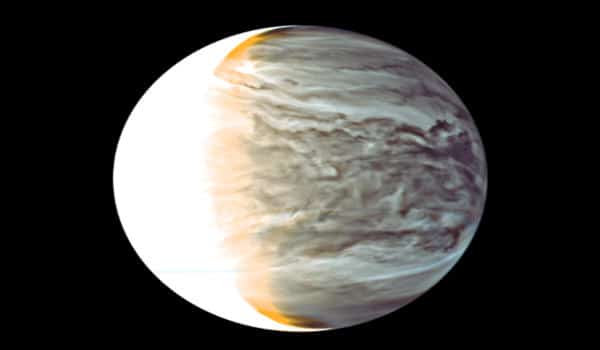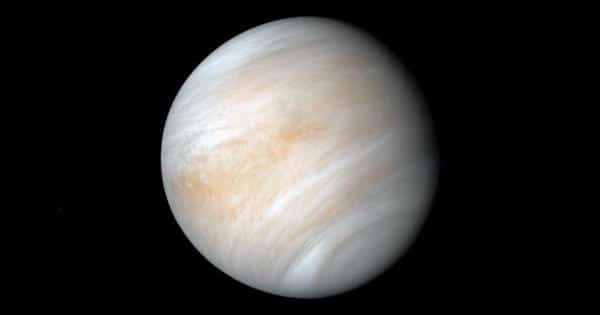Venus is a mystery. It’s the planet next door, but it doesn’t reveal much about itself. An ominous cloud cover smothers a harsh landscape pelted by acid rain and baked at temperatures capable of liquifying lead.
Now, new observations from the safety of Earth are shedding light on some of Venus’ most fundamental properties. A UCLA-led team has determined the exact length of a day on Venus, the tilt of its axis, and the size of its core by repeatedly bouncing radar off the planet’s surface over the last 15 years. The findings were published in the journal Nature Astronomy today.
Both the Earth and Venus are rocky planets with nearly the same size, mass, and density. Despite this, they evolved in very different ways. Fundamentals such as the number of hours in a Venusian day provide critical information for understanding the divergent histories of these neighboring worlds.
“Venus is our sister planet, and yet these fundamental properties have remained unknown,” said Jean-Luc Margot, a UCLA professor of Earth, planetary and space sciences who led the research.
Changes in Venus’ spin and orientation reveal how mass is distributed within the planet. Knowledge of the planet’s internal structure, in turn, fuels an understanding of its formation, volcanic history, and how time has altered the surface. Furthermore, without precise data on how the planet moves, future landing attempts may be off by up to 30 kilometers.
“Without these measurements,” said Margot, “we’re essentially flying blind.”
According to the new radar measurements, an average day on Venus lasts 243.0226 Earth days or roughly two-thirds of an Earth year. Furthermore, Venus’s rotation rate is constantly changing: A value measured at one time will be slightly greater or less than a previous value. The team estimated the length of a day based on each individual measurement, and they found differences of at least 20 minutes.
“That probably explains why previous estimates didn’t agree with one another,” Margot said.
The variation is most likely due to Venus’s dense atmosphere. It exchanges a lot of momentum with the solid ground as it sloshes around the planet, speeding up and slowing down its rotation. This occurs on Earth as well, but the exchange adds or subtracts only one millisecond to each day. The effect is much more dramatic on Venus because its atmosphere is roughly 93 times as massive as Earth’s, giving it much more momentum to trade with.

The UCLA-led team also reports that Venus tilts to one side by precisely 2.6392 degrees (Earth is tilted by about 23 degrees), a factor of ten improvements over previous estimates. Repeated radar measurements revealed the glacial rate at which Venus’ spin axis orientation changes, much like a spinning child’s top. On Earth, this “precession” takes approximately 26,000 years to complete one cycle. Venus requires a little more time: approximately 29,000 years.
Using these precise measurements of how Venus spins, the team calculated that the planet’s core is about 3,500 kilometers across, which is quite similar to Earth, though they cannot yet determine whether it is liquid or solid.
Venus as a giant disco ball
From 2006 to 2020, Margot and his colleagues aimed radio waves at Venus from the 70-meter-wide Goldstone antenna in California’s Mojave Desert on 21 separate occasions. Those radio waves bounced off Venus and returned to Earth a few minutes later. The radio echo was detected at Goldstone and at West Virginia’s Green Bank Observatory.
“We use Venus as a giant disco ball,” Margot explained, describing the radio dish as a flashlight and the planet’s landscape as millions of tiny reflectors. “We illuminate it with a flashlight that is 100,000 times brighter than a standard flashlight. And by tracking the disco ball’s reflections, we can infer properties about the spin [state].”
The complex reflections cause the return signal to brighten and dim erratically as it sweeps across Earth. The Goldstone antenna detects the echo first, followed by Green Bank about 20 seconds later. The exact time it takes for the echoes to arrive at the two facilities reveals how fast Venus is spinning, while the specific window of time when the echoes are most similar reveals the planet’s tilt.
To ensure that Venus and Earth were properly positioned, the observations required precise timing. And both observatories had to be in perfect working order, which wasn’t always the case. “We discovered that it’s actually difficult to get everything to work perfectly in a 30-second period,” Margot explained. “Most of the time, we get some information. However, it is unusual for us to obtain all of the data that we had hoped for.”
Despite the difficulties, the team is pressing on and has set its sights on Jupiter’s moons Europa and Ganymede. Many scientists believe that Europa, in particular, conceals a liquid water ocean beneath a thick ice shell. Ground-based radar measurements could strengthen the case for an ocean while also revealing the thickness of the ice shell.
The team will also continue to bounce radar off of Venus. With each radio echo, the veil over Venus lifts a little more, revealing our sister planet in greater detail.













